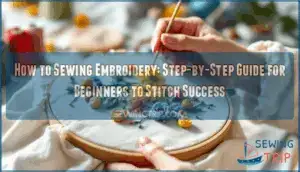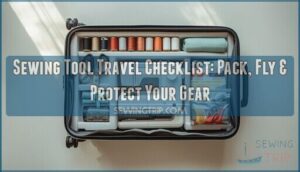This site is supported by our readers. We may earn a commission, at no cost to you, if you purchase through links.

From tangled threads to the first smooth satin stitch, every step marks a small victory and a lesson you can feel in your fingers. Whether you’ve tangled floss before or never picked up a hoop, the path to embroidery mastery always begins with that first stitch.
Table Of Contents
Key Takeaways
- Embroidery starts with choosing the right tools—fabric, threads, needles, and stabilizers—that set the stage for smooth, creative stitching.
- Building skill comes from practicing foundational stitches and techniques like straight stitch, satin stitch, controlling thread tension, and trying free-motion embroidery.
- Proper fabric selection and preparation, including color fastness checks and stabilization, prevent common issues like puckering and uneven stitches.
- Transferring patterns onto fabric and caring for finished embroidered pieces are just as important as stitching, ensuring lasting, vibrant results.
Embroidery Basics: Supplies and Techniques
Getting started with embroidery is easier when you know which tools to reach for and which techniques to practice. Let’s take a look at the supplies and basic methods every beginner should know.
In this section, you’ll see exactly what you need and how to build a strong foundation.
Lesson 1: Beginner Supplies
There’s something special about picking out your first embroidery supplies—it’s like gathering your tools before setting off on a creative adventure. You’ll want fabric stabilizers to prevent puckering, and the right needle types for smooth sailing. The embroidery thread you choose should suit both your design and your hoop setup. Tool maintenance—think clean scissors and tangle-free thread—sets the groundwork for joyful stitching. Hoops compared, nothing beats the confidence of a snug embroidery hoop holding your chosen fabric, ready for your first stitches.
- The excitement of unopened embroidery threads
- Feeling fabric stabilizers in your hands
- Experimenting with needle types—each one a new possibility
- Organizing your toolkit, picturing future embroidery designs
Lesson 2: Essential Techniques for Beginners
Once you’ve gathered your tools, the real fun begins as you start picking up the basic techniques that make each stitch feel more natural in your hands. Focus your attention on the way thread glides through fabric—try a Straight Stitch or a Satin Stitch to see the difference. Practice adjusting Stitch Length and Thread Weight to explore texture. Don’t be afraid to try Free Motion, even if you’re new.
Here’s what to keep in mind:
- Master smooth thread paths
- Experiment with Stitch Length for texture
- Try Free Motion embroidery techniques
- Control Thread Weight for bold or delicate designs
- Tackle the basics of machine embroidery for beginners
Lesson 3: Tips and Tricks for Successful Embroidery
You’ve begun exploring core embroidery techniques, and now it’s time to add precision and polish to your projects. Choosing the right embroidery thread and conditioning it with beeswax reduces breakage and gives your stitches a smooth finish. Keep an eye on stitch density—less is often more, helping your embroidery designs look crisp and avoiding puckering.
Always use stabilizers or consider fabric stabilization to support your chosen fabric. Selecting the right fabric, like cotton or linen, can greatly impact embroidery project results.
If mistakes sneak in, don’t panic. Error reassessment is your best friend—careful removal and subtle design modification often work wonders. For smooth results with machine embroidery, double-check hoop tension and experiment with embroidery techniques to find your groove.
Getting Started With Hand Embroidery
If you’re ready to try hand embroidery, it all starts with a few practical choices. Before you stitch, you’ll want to pick the right fabric, transfer your favorite design, and find beginner patterns that feel inviting.
Here’s how you can get started.
Lesson 4: Choosing The Right Fabric
Ever wonder why some stitches lie flat and others pucker? It comes down to careful fabric selection and preparation. Think about these essentials before starting:
- Choose cotton or linen for stability and even weave structure.
- Check color fastness by damp testing—no one wants bleeding threads.
- Match thread count and technique suitability; the right fabric lets your creativity flow.
Fabric weight impacts embroidery design suitability.
Lesson 5: Transferring Patterns Onto Fabric
With so many ways to get your favorite design onto fabric, figuring out how to transfer an embroidery pattern can feel just as creative as the stitching itself.
Pattern Tracing with fabric marking tools or a light box keeps things simple, while Iron-On Transfers and Water Solubles accommodate intricate embroidery designs with ease.
The Pouncing Method offers artistic flair when tackling larger projects. If you prefer a modern touch, disappearing ink pens guarantee clean fabric preparation.
Mastering the right embroidery design transfer sets the stage for every stitch ahead.
Lesson 6: Beginner Embroidery Patterns
A well-chosen pattern can spark your enthusiasm and help you build real skill, stitch by stitch. Pattern accessibility is at its highest ever—digital embroidery designs are just a click away, and today’s sewing projects offer everything from minimalist motifs to bold, nature-inspired themes. Kit popularity is soaring, especially patterns with clear instructions and a manageable stitch complexity for newcomers. For instance, consider searching for beginner embroidery designs that blend classic stitches like satin stitch or French knots with creative color palettes—current design trends favor these playful combinations.
- There’s something truly inspiring in watching your favorite embroidery designs come to life, especially when you’ve adapted them with your choice of threads or transferred them with modern tools.
Digital resources and step-by-step embroidery design transfer guides make getting started with machine embroidery more approachable than ever. Explore, experiment, and let embroidery patterns fuel your creative journey.
Learning Basic Embroidery Stitches
Every stitch has a purpose, and getting comfortable with a few basics opens up a whole world of designs. You’ll find that some are simple, while others add new twists.
Here’s what you’ll need to know as you start learning the stitches ahead.
Lesson 7: Mastering Basic Stitches
Think of basic embroidery stitches as the building blocks of every project—once you master these, you can turn any plain fabric into a canvas full of color and personality.
Techniques like the Straight Stitch and Satin Stitch are essentials, perfect for outlining shapes, filling spaces, or adjusting texture.
Practice these fundamental stitching methods and you’ll soon be layering decorative stitching, experimenting with various stitch patterns, and even applying machine embroidery techniques that transform simple sewing into truly standout creative work.
Lesson 8: Exploring Other Embroidery Stitches for Beginners
Ready to shake things up? Taking your first steps beyond the basics opens the door to a whole new world of stitches that bring personality and flair to your embroidery. Maybe you’ve mastered the straight stitch, but have you tried the lively chain stitch or the flowing stem stitch yet? These simple variations lay the groundwork for more decorative stitching. French knots and seed stitch dots add texture and detail, while feather stitch brings a playful twist to your borders.
For even more variety, blend different stitch patterns in one project:
- Combine chain stitch and stem stitch to create vivid outlines in your embroidery designs—practical, eye-catching, and personal.
Lesson 9: Uncommon Embroidery Stitches
Ever wanted to give your embroidery designs a touch of true artistry? Uncommon embroidery techniques hold the key.
Add texture and dimension with Ceylon Stitch—it mimics knitting and works wonders for contemporary pieces. The Raised Stem stitch creates a basket weave effect, offering depth to floral motifs. Try the Palestrina Stitch for beaded borders or whip up petals with Woven Picot for three-dimensional flair.
Don’t forget Braided Techniques, which add substance and intrigue to your designs. As you master these decorative stitching techniques, your sewing toolkit becomes as creative as your imagination.
Frequently Asked Questions (FAQs)
Can You embroider with a sewing machine?
As the saying goes, “Where there’s a will, there’s a way.” You absolutely can embroider with a sewing machine by using free-motion stitching, stabilizer usage, and mindful needle selection, unlocking endless embroidery designs with classic sewing techniques!
How to use a machine embroidery machine?
Using an embroidery machine starts with machine setup, threading the machine, and selecting a stabilizer.
Load your embroidery design, secure fabric, adjust stitch settings, and use high-quality embroidery thread to bring vibrant designs to life with precision.
How do I get my sewing machine ready for embroidery?
Like telegraph keys switched to typewriters, machine conversion for embroidery begins with careful Sewing Machine Setup and Fabric Preparation.
Nail stabilizer selection, hooping fabric, and thread selection.
Dial in tension settings, needle choice, and master essential Sewing Machine Tips.
How to fix embroidery mistakes on a regular sewing machine?
Stitch removal with a seam ripper helps correct misplaced lines; for fabric repair, carefully weave threads. Design alteration covers small mistakes with creative Free Motion Embroidery.
Check tension readjustment, address fabric puckering, and prioritize machine maintenance for excellent results.
Is embroidery easy to learn?
Embroidery is easy to learn, but mastering it takes time and patience. The learning curve depends on your sewing skills, embroidery techniques, and project complexity.
Embroidery is simple to start but gradually reveals its richness through practice, patience, and growing creative skill
With regular practice, you’ll develop skill and creative expression using threads, designs, or a machine.
How do I choose the right fabric for my embroidery project?
Choosing fabric is like picking a dance partner—its weave type, fiber content, and weight shape every step.
Pre-washing fabric, checking color fastness, and matching stabilizers help guarantee your embroidery project’s foundation is stable, smooth, and color-true.
What are some common mistakes to avoid when starting embroidery?
Watch out for Tension Troubles and fabric puckering by choosing the right stabilizers and thread tension.
Pay attention to proper embroidery hooping, pattern transfer, and needle selection to avoid issues that stem from accidental machine settings or fabric choice.
Can I use regular sewing thread for embroidery?
You can use sewing thread for embroidery, but it may affect stitch quality and thread tension.
Embroidery thread, designed for specific thread weight and material, provides better machine compatibility and project suitability for intricate embroidery designs and various fabric and thread combinations.
How do I transfer a pattern onto fabric for embroidery?
Perfect pattern transfer starts with crisp lighting and the right fabric marking tools. Choose a fabric-friendly, disappearing ink pen for clear embroidery designs.
Secure your design, trace accurately, mind design placement, and check lines before threads meet fabric.
How do I care for embroidered garments after sewing?
Care for embroidered garments gently—wash inside out using mild detergent and cold water. Air dry flat, avoiding harsh heat. For stubborn stains, spot clean.
Store folded with tissue to preserve fabric decoration, supporting your garment customization and sewing tips.
Conclusion
Imagine your needle as a compass, guiding you through a landscape where fabric becomes terrain and every stitch a new path. By learning how to sew embroidery, you’ve opened a door to an art that feels both ancient and alive.
Patterns may begin as guidelines, but your hands make them sing with personal meaning. In time, muscle memory and vision blend—turning messes into masterpieces.
The next time you pick up your hoop, you’ll know exactly where to begin.
- https://www.sewvacdirect.com/embroidery/
- https://labeloom.com/blogs/blog/how-to-fix-embroidery-mistakes-a-comprehensive-guide-to-restoring-your-stitches
- https://archive.bridgesmathart.org/2024/bridges2024-243.pdf
- https://www.maggieframes.com/blogs/embroidery-blogs/best-fabrics-for-embroidery-choosing-the-right-material-for-flawless-results
- https://www.fortunebusinessinsights.com/embroidery-market-104976










